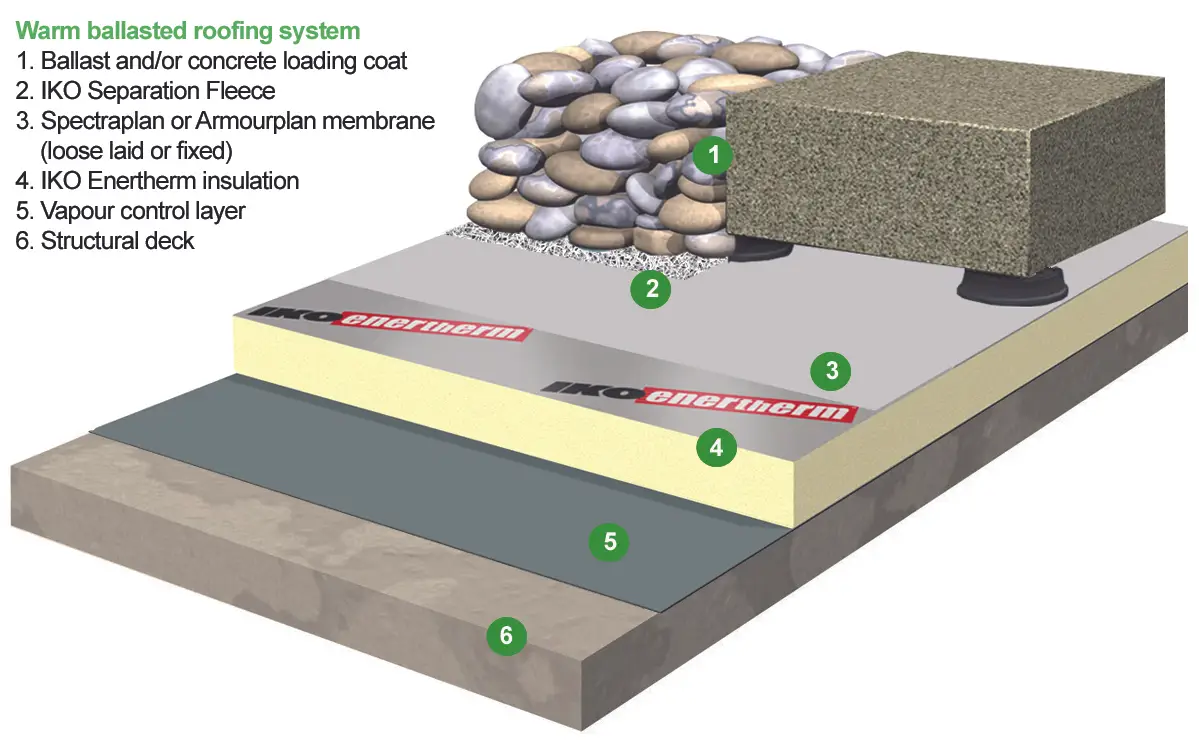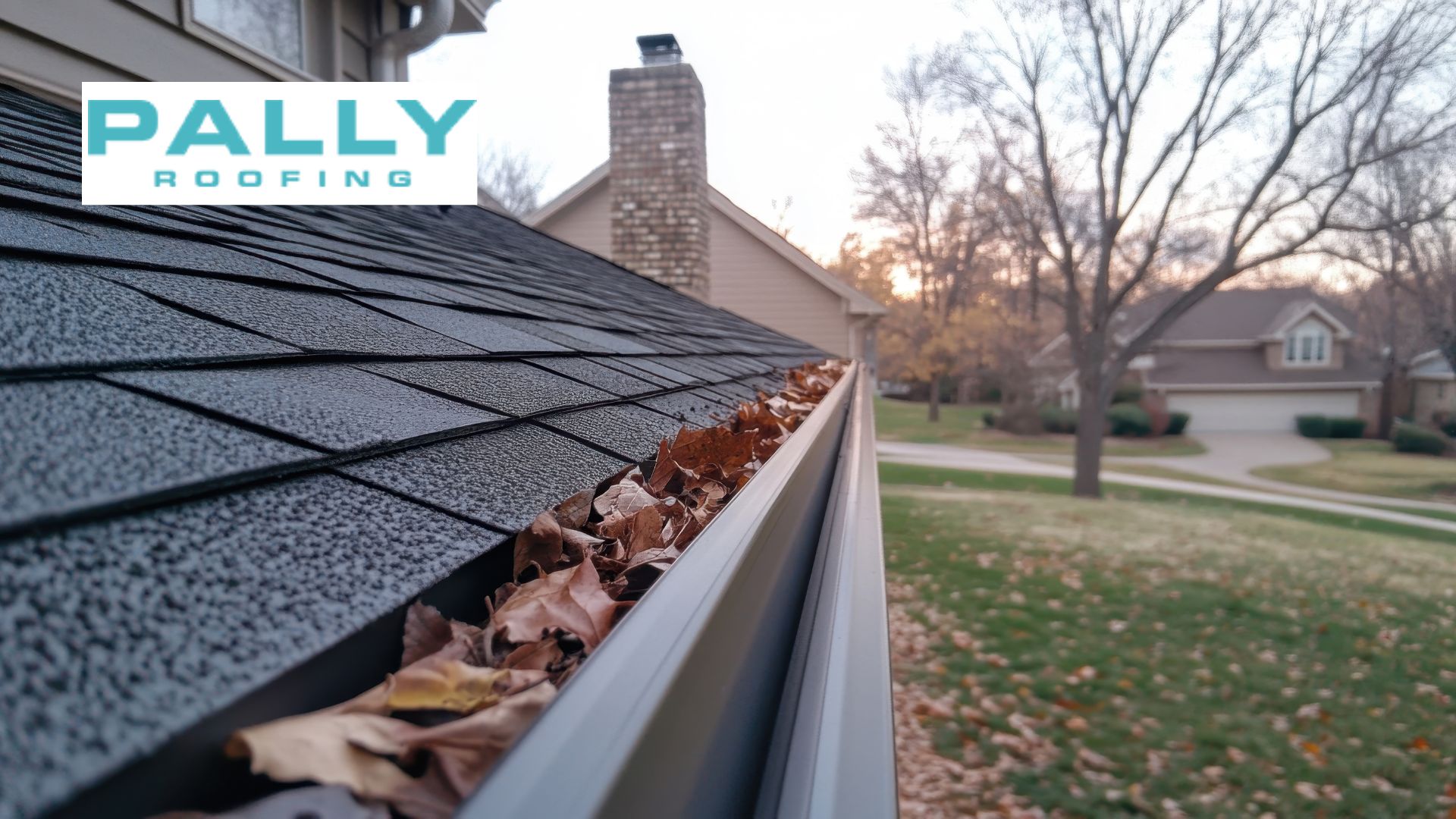Last updated on November 12th, 2024 at 08:25 am
Choosing the right roof for a commercial property can be a difficult decision. With many options available, balancing sustainability, cost-effectiveness, and longevity is important. One that stands out in all these areas is the ballasted roofing solution. But what exactly is a ballasted roofing system, and how does it compare to other roof types? In this guide, we’ll show you the pros, cons, and everything else you need to know about ballasted roof installation to help you decide if it’s right for your property.
Table of Contents
What Is a Ballasted Roof?
A ballasted roof is a system in which heavy materials such as rock or concrete pavers hold the roofing material together. Unlike traditional roofs that are mechanically fastened or glued together, a ballast roof is solid under its weight. This unique method offers many advantages, especially for large commercial buildings.
Key Components of a Ballasted Roof:
- Membrane: A waterproof layer that protects against leaks.
- Insulation: Helps regulate the building’s internal temperature.
- Ballast Materials: Heavy items like gravel or pavers that secure the membrane and protect it from UV damage.
Ballasted roofs stand out compared to traditional roofs for their durability and low maintenance, making them ideal for homeowners looking for a long-term solution.
How Ballasted Roofing Systems Work

Source: ikogroup
A ballasted roofing system loosely lays the membrane over the roof deck when the insulation is underneath. Ballast is typically distributed over a gravel or concrete paver membrane to provide the load required to protect the system. This weight-based process eliminates the need for mechanical fasteners, reduces potential leak areas, and speeds installation.
Source: web.ornl.gov
How Each Component Functions:
- Membrane: Acts as the waterproof barrier, preventing leaks.
- Insulation: Maintains stable building temperatures, promoting energy efficiency.
- Ballast Materials: Protect the membrane from UV exposure and provide stability without additional penetrations.

Source: web.ornl.gov
This unique setup makes ballasted roof installation an efficient and effective solution, especially for commercial properties.
Benefits of Ballasted Roofs
Source: heatspring
There are many benefits of ballasted roofs that make them popular with commercial property owners:
1. Energy Efficiency:
Ballast materials such as gravel or pavers reflect sunlight, reducing heat absorption and helping to cool the building. This energy-efficient system can reduce cooling costs, especially in hot climates.
2. Sustainability:
Ballasted roofing systems are more environmentally friendly than traditional roofs, as they can easily be recycled at the end of their life. Long-term maintenance is unnecessary because fewer glue or fasteners have fewer possible failure spots.
3. Cost Savings:
Ballasted roof installation is usually faster and less labor-intensive than conventional techniques, saving money upfront. Furthermore, the ballast layer shields the membrane from damage, cutting maintenance expenses during the roof’s lifespan. While installing a ballasted roof in the USA varies depending on location and building type, the long-term savings can make it a cost-effective choice.
4. Durability and UV Protection:
The ballast shields the roofing membrane from UV radiation, which may harm roofing materials over time. This added protection increases the lifespan of ballasted roofs, making them an excellent long-term investment.
5. Quick Installation:
Installations can be completed faster and with fewer adhesives and packaging than other methods. This time efficiency makes ballasted roofing systems especially useful for large commercial projects that need to reduce downtime.
Drawbacks and Considerations of Ballasted Roofs
While the benefits of ballasted roof systems for commercial buildings are substantial, there are some factors to keep in mind:
1. Weight Load:
The ballast material adds a lot of weight to the roof. Before choosing this option, it is important to ensure that the structure of the building can support the additional load, especially for tall buildings.
2. Wind Uplift Limitations:
Ballast roofs may need additional safety measures to prevent ballast migration in windy areas. Heavier gravel, such as concrete pavers, can help provide more stability in these situations.
3. Maintenance:
While ballasted roofing systems are low maintenance, periodic inspections are often recommended to ensure continuous ballast distribution. Changes in the ballast over time can expose portions of the veins, which can affect performance.
Why Choose Pally Roofing for Your Ballasted Roof Needs?
When it comes to ballasted roof installation, expertise makes all the difference. Pally Roofing has over 15 years of experience with ballasted roofing systems across the USA, ensuring that our clients receive high-quality installations that last. Here’s why Pally Roofing is the right choice for your ballasted roof project:
- Expert Installation: Our team has extensive experience in ballasted roofing systems and follows industry best practices to deliver a quality installation every time.
- Customized Solutions: Each building has unique needs. Pally Roofing considers each property’s architectural and roofing needs, recommending the best roof ballast materials and installation approach for optimal results.
- Commitment to Sustainability: Pally Roofing uses eco-friendly products and prioritizes sustainable methods whenever possible. Without compromising sustainability, we assist you in making environmentally responsible decisions for your building.
- Comprehensive Maintenance Plans: To ensure long-term performance, Pally Roofing offers maintenance programs that include regular inspections and maintenance to help protect your investment and extend the life of your roof.
Types of Roof Ballast Materials

Source: Waterproofmag
Choosing the suitable ballast material is essential for optimizing your roof’s performance. Here are some standard options:
- Gravel: A cheap and practical option for commercial roofs. Gravel provides reliable UV protection and stability.
- Concrete Pavers: The heavier, more durable concrete is suitable for roofs that may occasionally be subjected to foot traffic or need additional wind resistance.
- Green Roof Ballast: Soil and plants can act as ballast, creating a “green roof” that provides aesthetic and environmental benefits, including increased insulation and improved ventilation
Choosing Between a Ballasted Roof vs. Traditional Roof
When deciding between a ballasted roof and a traditional roof, it’s essential to consider your building’s location, structural needs, and long-term goals for sustainability and maintenance:
- A ballasted roof is ideal for buildings that prioritize energy efficiency, ease of installation, and low maintenance, especially in mild climates. This system’s reduced environmental impact and low maintenance make it attractive to environmentally and economically conscious property managers. However, it may not be suitable for windy locations or buildings that cannot withstand additional loads.
- A traditional roof offers better wind resistance and is often more customizable for various building types. However, achieving similar energy efficiency may require more frequent maintenance and potentially higher costs.
Choosing the right roof depends on a balance of structural requirements, sustainability goals, and budget considerations.
Conclusion:
A ballasted roof can be an ideal solution for commercial buildings seeking a durable, low-maintenance, and energy-efficient roofing option. While weight and wind resistance must be considered, the energy efficiency benefits of ballasted roofs and their long-lasting durability make them a solid choice for building owners focused on sustainability and cost savings.
Ready to see if a ballasted roof is the right fit for your property? Contact Pally Roofing today for a consultation. Our experts will help you explore your options, assess your building’s needs, and guide you through every step of the installation process to ensure your roof performs at its best.
Frequently Asked Question
What Is A Ballasted Roof System, And How Does It Work?
A ballasted roof system is a flat roofing system where gravel, pavers, or tiles hold insulation and waterproofing materials in place. The weight of the ballast keeps the roofing materials secure and helps prevent them from being lifted by high winds. The system avoids fasteners, making it a more straightforward installation method.
What Are The Advantages Of A Ballasted Roof System?
Ballasted roof systems offer several benefits: Energy efficiency: The weight of the ballast can help regulate temperature, keeping the building cooler in summer and warmer in winter. Sound absorption: The ballast also provides excellent noise insulation, making it ideal for buildings in noisy areas. Protection from UV rays: The ballast shields the roof membrane from harmful UV rays, which can extend the roof's life. No need for fasteners: Since no drilling is required, there is a lower risk of leaks, and the roofing system is easier to maintain.
What Are The Potential Drawbacks Of A Ballasted Roof System?
While there are many benefits, ballasted roofs also come with some drawbacks: Complex maintenance: Repairing a ballasted roof system can be challenging because the ballast must be carefully removed and replaced during maintenance or repairs. Weight concerns: The additional ballast weight can stress the roof structure, and extra reinforcement might be needed for some buildings.
How Do You Install A Ballasted Roof System?
The installation process of a ballasted roof system involves several steps: Waterproof membrane: First, a waterproof membrane is laid on the roof deck. Insulation: Insulation material is enhanced on the membrane to enhance energy efficiency. Ballast: Finally, a layer of ballast material (such as gravel, pavers, or tiles) is spread evenly over the insulation to hold it in place and secure the roofing system.
Are Ballasted Roof Systems Suitable For All Building Types?
Ballasted roof systems are best suited for flat or low-sloped roofs, typically found in commercial buildings, warehouses, and industrial facilities. However, they may not be suitable for: Buildings with pitched roofs. Areas with high seismic activity, where the ballast might shift during an earthquake.
Author
-

With more than 16 years of hands-on experience, Phillip Schmucker is the knowledgeable owner of Pally Roofing. His dedication to superior roofing services has earned him a reputable place in the industry. Phillip also shares his extensive expertise through writing, providing readers with practical tips and professional advice on various roofing topics. Follow him on LinkedIn.
View all posts






